For 16 years both Republican and Democrat FCCs worked to require that internet service providers (ISPs) deliver non-discriminatory access to their critical networks. These efforts have continually been opposed by the internet companies, including through a series of successful court appeals of the FCC’s decisions.
In 2015, the Obama FCC adopted (on a 3-2 vote with all Republicans opposing) an Open Internet Rule (also called net neutrality). It was the first such ruling to be upheld by the U.S. Court of Appeals against the challenges of the ISPs.
The Open Internet Rule provided that ISPs could not discriminate against companies wanting to use their network to reach consumers. This meant no blocking, no throttling, and no requiring payment to prioritize internet delivery. The Order also contained a General Conduct Rule that the actions of the ISPs going forward must be “just and reasonable.”
In 2017, following the election of Donald Trump, the Republicans who voted against net neutrality were in control at the FCC. The Trump FCC moved quickly to repeal the Open Internet Rule.
The Biden FCC inherits this legacy. In addition, it inherits the Trump FCC’s defiance of a court-ordered review of significant parts of the repeal.
The Trump FCC Granted the ISPs Their Long-Held Lobbying Strategy
In September 2013, The Washington Post ran a story headlined, “Here’s how the telecom industry plans to defang their regulators.” The article began, “As phone companies retool their businesses for the Internet, they are calling on Washington to liberate them from their longtime overseer, the Federal Communications Commission…telecom giants including Verizon, AT&T and Comcast have launched multiple efforts to shift regulation of their broadband business to other agencies that don’t have nearly as much power as the FCC.” That other agency was the Federal Trade Commission (FTC).
Three months after taking over as Trump’s FCC Chairman, Ajit Pai gave industry lobbyists their wish. In early April, before making his plans public, he brought industry lobbyists together to tell them about his plan to eliminate the FCC’s authority over internet connections and shift the responsibility to the FTC.
It was a remarkable moment. That the Trump FCC would eliminate the Obama FCC’s rules was no surprise, since the Chairman had voted against the Order when he was a Commissioner. But the Trump FCC went much further. The agency responsible for the nation’s networks disclaimed responsibility for the most important network of the 21st century!
In Trumpian doublespeak, the Chairman named his action to restrict freedom of use on the internet “Restoring Internet Freedom.”
Non-Discrimination on Critical Networks Has Been the Law Since Before the Civil WAr
In June 1860, President James Buchanan signed the Pacific Telegraph Act. Not only did the law fund the transcontinental telegraph but is also provided that telegraph messages shall be “impartially transmitted in order of their reception.” Such non-discrimination was only logical; the telegraph had become a critical means of communication and access to it had to be open to all.
The idea of such non-discriminatory access to critical pathways is hundreds of years old. As civilization struggled to escape the Dark Ages and feudalism, English common law developed as a tool to protect the people from the powerful. One of its basic principles was the “duty to deal.” A traveler could not be denied or discriminated against in using the ferry to cross the river, for instance. Nor could that traveler be denied shelter and food at the tavern along the roadway. It was that duty to deal concept that found continued life with a new technology in the Pacific Telegraph Act.
As technology advanced from telegraph to telephone, the same non-discrimination concept advanced alongside. The term used for such non-discrimination was “common carrier.” That the internet exists is a consequence of common carrier networks. In its early days, the internet was connected over telephone lines and the phone companies were required to allow access to those telephone lines. Had the telephone companies been able to deny attaching modems to their lines to allow computers to talk to each other, the internet could have been stillborn.
From “Telecommunications Service” to “Information Service”
As networks evolved from analog to digital, what had previously been a clear-cut difference between the network and the content that rode on it became clouded, since both the network protocols and the content carried were digital zeroes and ones. Recognizing this, the Congress created two classifications in 1996: a “telecommunications service” (i.e., the networks), and an “information service.” The former would be regulated as a common carrier.
The Obama FCC, in 2015, ruled that ISPs were a telecommunications service with the non-discriminatory responsibilities of a common carrier (although it was careful to also rule that many traditional aspects of common carrier regulation, like ex ante price regulation, would not be applied to ISPs). In 2017, the Trump FCC reversed that decision, declaring ISPs to be information services. It was an exercise in pretzel logic in which the Trump FCC held that because the ISP carried content (information services), the network was itself content and should be unregulated. It was a defying decision; the equivalent of saying that because a railroad carries corn, it should be regulated like corn.
In the Court of Appeals decision upholding the Trump FCC’s decision, Judge Patricia Millett (concurred in by Judge Robert Wilkins) called out this twisted logic: “I am deeply concerned that the result [upholding the Trump FCC] is unhinged from the realities of modern broadband service.” To carry the Trump FCC’s convoluted theory to its logical conclusion, the judges wrote, “everything (including telephones) would be an information service.”
Beyond such flawed logic, the Trump FCC washed its hands of authority over the consumer and competition issues associated with ISPs. The Chairman announced, “we decided that the principal overseer of ISPs should be the Federal Trade Commission to ensure that consumers and competition are protected.” Four years after the Post revealed the ISPs plan to get out from under the FCC, the Trump FCC bowed to their wishes.
The Court of Appeals upheld the Trump FCC’s repeal of net neutrality in accord with the Supreme Court’s Chevron decision that an “expert agency” should receive “deference” in its judgement. It was the same basis under which the same court upheld the Obama FCC Open Internet Rules.
“By its twisted logic, the Trump FCC walked away from 600 years of common law and ended 157 years of encouraging non-discrimination on America’s critical networks.”
By its twisted logic, the Trump FCC walked away from 600 years of common law and ended 157 years of encouraging non-discrimination on America’s critical networks. Then the agency responsible for the nation’s networks washed its hands and passed its important responsibilities to another agency with less authority and expertise.
Internet Monopolies
At the time of adoption of the Open Internet Order, three-out-of-four Americans had, at best, access to only one internet service that could even plausibly be called high-speed, as illustrated by this FCC chart:
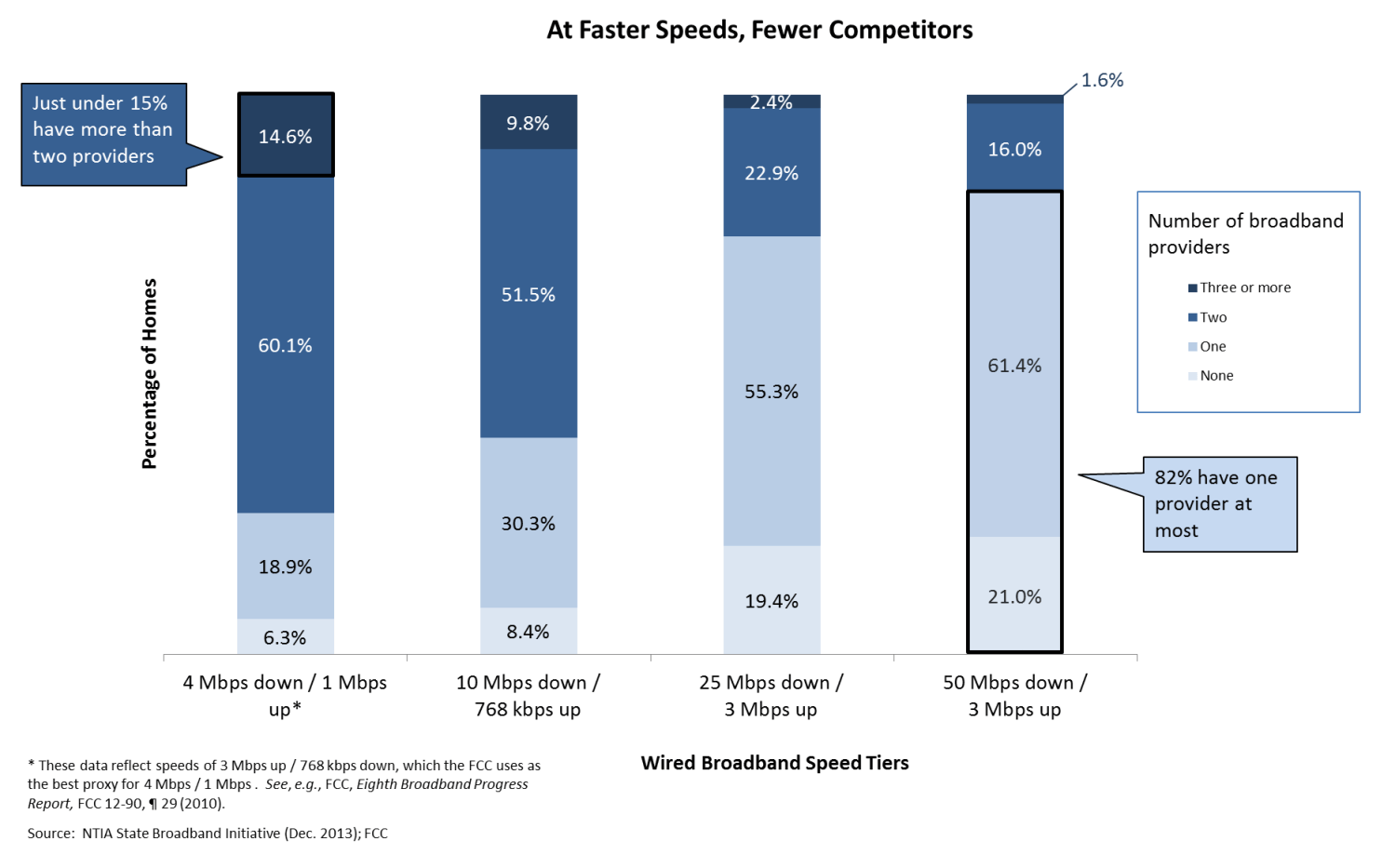
When the Trump FCC took over in 2017, it conveniently ceased measuring the level of ISP competition. But here’s what we do know: The largest number of broadband subscribers – 67 percent – are cable company subscribers and the cable companies have long enjoyed the benefits of exclusive franchises. Trying to deal with this lack of competition, the Obama FCC required Charter Communications to build a competitive alternative for four million homes as a condition of its merger with Time Warner Cable. The Trump FCC vacated that requirement in its first four months in office.
The Investment Con
Like a drunk uses a lamppost, the ISPs and the Trump FCC supported repealing 157 years of non-discrimination on critical networks with the assertion that net neutrality “discourages investment” in broadband infrastructure.
“Under the heavy-handed regulations adopted by the prior Commission in 2015,” Trump Chairman Pai told Congress, “network investment has declined for two straight years.” Using the “say-it-often-enough” strategy, he repeatedly made that fact-free claim. “After the FCC embraced utility-style regulation,” he told the Mobile World Congress, “the United States experienced the first-ever decline in broadband investment outside of a recession.”
Multiple studies have disproven this claim. An expansive study from George Washington University, found “net neutrality rule changes in the United States had no impact on telecommunication industry investment levels.” This confirms the study by consumer group Free Press that showed ISPs actually increasing their broadband investment during the pendency of the Obama Open Internet Rules.
The Trump FCC’s disinformation campaign was exposed by the ISPs themselves. When the ISPs spoke to their investors they delivered a different message. Tom Rutledge, CEO of Charter Communications: “Title II, it didn’t really hurt us; it hasn’t hurt us.” Randall Stevenson, CEO of AT&T reported in December 2015 they would “deploy more fiber” in 2016 (post-FCC action) than in 2015 (pre-FCC action). The telecom lobby, USTA, said, “from the end of 2015 [post-FCC rule] to mid-2017 [pre-repeal of that rule], U.S. fiber deployment grew from 21 percent to 29 percent of homes.”
The final nail was put in the big con by the “watch what I do, not what I say” results that followed the repeal of net neutrality. “AT&T, Comcast Dramatically Cut Network Spending Despite Net Neutrality Repeal,” one headline proclaimed. The article reported that Comcast’s overall capital expenditures (capex) “dropped in 2019 by roughly 10.5%” and AT&T’s capex was at the “lowest total in nearly a decade.” Another headline announced, “Charter will spend less on cable network in 2019 but charge customers more.”
Ongoing Abuses
“But where are the abuses?” is the oft-heard refrain against net neutrality. Such rhetoric, of course, ignores the reason that the whole issue started back in 2005 was ISP efforts to limit or control third party use of the network. The economic incentives for such abuses remain.
“Broadband providers have been quietly taking advantage of an internet without net neutrality protections and where the FCC has no legal authority to police harmful conduct by broadband providers,” public interest group Public Knowledge concluded in a 2019 study.
Part of the big con on net neutrality is the ISPs’ claim to “support net neutrality” while opposing its regulatory enforcement. The three core principles of net neutrality are no blocking, no throttling, and no paid prioritization to create “fast lanes and slow lanes.” Recently, because there is no longer a rule against it, ISPs have dropped the prohibition of paid prioritization from the list of things they won’t do.
Throttling of services is commonplace. Researchers from Northeastern University and University of Massachusetts found wireless carriers slow down internet speed for selected video streaming services, not just for network management (which is permitted), but “all the time, 24/7, and it’s not based on networks being overloaded.” Sprint throttled traffic to Skype which competed with Sprint’s calling service. Verizon even throttled a fire department’s service during the California wildfires.
The ISPs have reneged on the pledge made during the 2015 debates over net neutrality that they would not charge extra to create “fast lanes” and “slow lanes.” Broadband ISP Cox Communications created a “fast lane” for gamers willing to pay extra. Comcast made mobile customers pay more if they wanted speeds necessary for high quality video.
Beyond the “big three” net neutrality issues, the Obama FCC established the General Conduct Rule to permit the FCC to keep abreast of unanticipated future developments. At the close of the Obama term, the agency had begun an investigation into “zero rating,” the practice of not charging for mobile data if the customer was using a preferred service. The Trump FCC killed that inquiry and opened the door for networks to self-preference their own content.
After AT&T bought Time Warner and became an entertainment company as well as a network company, it began preferencing its video content against competitors. AT&T subscribers, for instance, could receive HBO Max without incurring any data charges; but if the customer wanted Netflix or Showtime, the customer had to pay for the data required to deliver the service.
While AT&T continued to actively discriminate in favor of HBO Max on its wireless network, it complained other companies were “bottlenecks” (its term) to the distribution of content from AT&T-owned WarnerMedia. “AT&T Chief Says Tech Giants Hold Too Much Power Over Streaming,” a Wall Street Journal headline explained about Amazon Prime and Roku refusal to open their app stores to HBO Max.
The Biden FCC Inheritance
As mentioned previously, the Trump FCC ignored an order from the Court of Appeals to reconsider key parts of its Order eliminating the jurisdiction over ISPs. The failure of the Trump FCC to obey the Court may have created an opportunity for the Biden FCC to move rapidly to restore net neutrality since the original FCC proceeding is still open.
The failure of the Trump FCC to obey the Court may have created an opportunity for the Biden FCC to move rapidly to restore net neutrality since the original FCC proceeding is still open.
One concern of the Court was the Trump FCC’s assertion that it had preempted states from enacting their own net neutrality laws even though the federal government (through the FCC) had failed to exert its own jurisdiction. The Court questioned that assertion, instructing the Commission to come back with either a better explanation or an alternative. On February 23, a different federal court ruled that that the FCC’s repeal of the federal net neutrality rule did not preempt the net neutrality law California passed following the Trump FCC’s action.
The DC Court of Appeals also required the FCC to reconsider the effect of ISPs no longer being common carriers on their public safety duties, as well as the decision’s impact on subsidies for low-income internet access. The fact the Trump FCC chose to disregard the instructions of the Court means the Biden FCC will have to answer the Court’s issues and in so doing, could alter the overall decision without starting a new and time-consuming proceeding.
Net Neutrality’s Maginot Line
The ongoing challenge of regulatory oversight in an era of rapid technological change is to maintain the flexibility to deal with unanticipated developments. What is essential for the future of meaningful net neutrality, therefore, is the agility to adjust to new technology and new marketplace behaviors. It was for this reason that the Obama decision included a “General Conduct Rule” that empowered the agency to determine whether the action of an ISP was “just and reasonable.” The inquiry into self-preferencing started by the Obama FCC, for instance, was based on whether the practice violated the General Conduct Rule. The companies hated the General Conduct Rule because it gave the FCC continuing oversight of their internet activities.
No doubt, when the Biden FCC revisits the net neutrality question, the ISPs and their allies will again fight what they will describe as the “regulatory uncertainty” of the General Conduct Rule. If they succeed in defining net neutrality as only blocking and throttling, the ISPs will have created a digital Maginot Line.
Like the Maginot Line that proved of no value at the outset of World War II, a fixed set of rules would be easy for a nimble network to get around. To encase the FCC’s open internet activities in the concrete of rigid rules would be as foolish as to entrust the defense of France to concrete fortifications at a time of the rapid blitzkrieg.
Overwhelming Public Support
A public opinion poll taken shortly after the Trump FCC repealed net neutrality found 86 percent of Americans opposed to the repeal. This included 82 percent of Republicans and 90 percent of Democrats.
America’s internet providers are not bad actors, but they preside over the most powerful and pervasive network in the history of the planet. Occupying such a critical position, they cannot simply be allowed to make their own rules to serve their own interests. Similarly, the agency Congress has created to oversee the nation’s networks cannot wash its hands and be subsumed into a digital industrial complex.
The public interest that is inherent in open and non-discriminatory networks has been well established for over half a millennium. The Trump FCC walked away from that responsibility; now it falls to the Biden FCC to stand up for consumers and a competitive and innovative internet.
AT&T, Comcast, Charter Communications, and Verizon are general, unrestricted donors to the Brookings Institution. The findings, interpretations and conclusions in this piece are solely those of the author and not influenced by any donation.
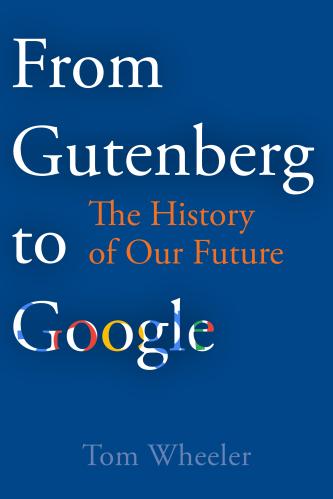
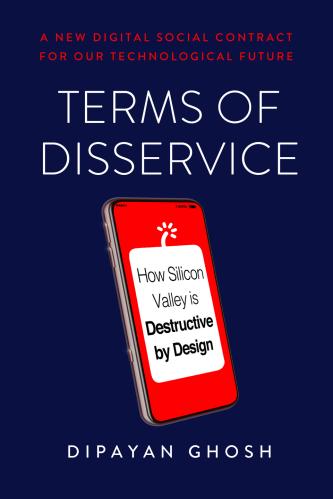
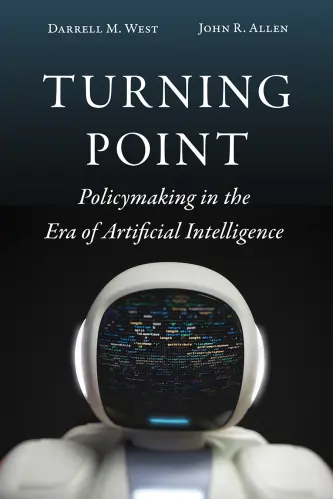

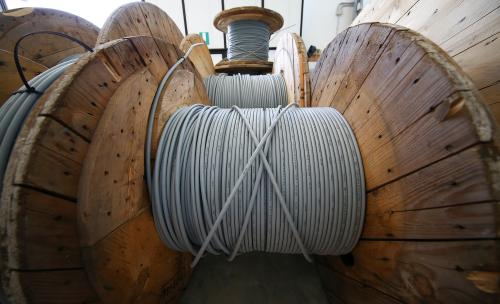





Commentary
Restoring non-discrimination to the 21st century’s most important network
Part 4 of Build Back Better with Biden FCC
February 25, 2021